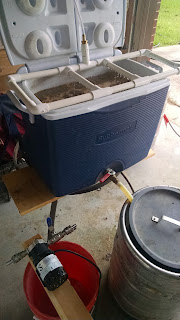One of my favorite beers that I was lucky enough to get to
try last year was Saison Bernice from Sante Adarius Rustic Ales. I was able to
drink practically as much as I wanted from What the Funk?! last year and
received a bottle in a trade a few weeks later. Since I already knew how
awesome that beer was I immediately knew that I wanted to harvest the dregs to
try to use them in a beer. Tim Clifford was nice enough to give out the recipe
on Brewing Network’s Sour Hour. Knowing this I figured I might as well at least
attempt to make something similar (add try my hand at West Ashley as well). The
recipe itself is not very complicated. I believe most of the grain bill is for
mouthfeel, body, and color. The real magic is from the yeast and bug culture.
Appearance: Pours a hazy orange with yellow hues and a thin
white head that fades quickly. Oddly enough I bottled in two different bottle
sizes. The larger bottles are well carbonated but the smaller bottles are not.
Aroma: Green apples, stone fruit, peach, pear, with some
spicy saison phenols. The most noticeable aroma is green apple. I’m not sure if
it’s a “green” beer side effect or a characteristic from the yeast. I would
prefer there be less green apple but there is a nice level of complexity with
the saison characteristic still making an appearance. I’m curious to see if
time will help clean up the apple notes.
Flavor: Like the aroma green apple is the predominate flavor
with hints of pear and spices rounded out with some clean lactic acid. The
acidity is definitely lactic, which compliments and brings out the green apple
tartness.
Mouthfeel: The carbonation varies with bottle size. The
smaller bottles it’s undercarbonated with a light carbonation and slick creamy
mouthfeel. The larger format bottles are medium-high carbonation with a dry
lactic finish and medium body. The body is nice considering how dry it
finished. I’m not sure why the carbonation level varies like it does since I
bottled this as a single batch.
Overall: I’m pleased with the character of this beer,
although there are some things I would change. In the future I would try to add
3711 along with the 3724 the way Sante does for Bernice. I didn’t have any 3711
on hand at the time. I feel it would have added some extra fruity saison
character that I don’t get from 3724. Another option would have been to blend
back some straight 3711 saison at bottling. This would have helped to cut the
acidity, which I also thought was a little high for the beer. As far as the
green apple goes, I’m not sure what I could have done to prevent that. My best
guess would be this is why Sante uses 3711 along with 3724. 3724 has a tendency
to drop out of suspension halfway through fermentation, which could lead acetaldehyde
production and it remaining in the beer. 3711 would have remained in suspension
and cleaned up any remaining off flavors from fermentation. While the beer did
reach full attenuation, it could have been from Brett as opposed to Sac, which
is why that flavor was not cleaned up. I guess that gives me an excuse to brew
this beer again.





